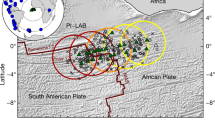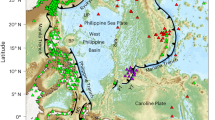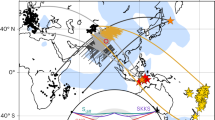Abstract
BENEATH an active mid-ocean ridge, the mantle upwells in response to the divergence of the newly formed plates, leading to high temperatures and pressure-release melting below the ridge axis. The width of the upwelling region and the amount of melting depend on mantle rheology1–5, but all models predict a maximum decrease in seismic velocity at the ridge axis. It has also been suggested, however, that the alignment of anisotropic minerals by shear in the upwelling mantle will increase seismic velocity for rays travelling subvertically through the upwelling zone6,7. Here we report the observation of a consistent pattern of anomalously early P-wave arrival times at an array of ocean-bottom seismographs deployed across the axis of the southern Mid-Atlantic Ridge: P-waves from distant earthquakes arrive earlier at stations near the axis than at those further away. Our results are consistent with a model of anisotropy in which the degree of mineral alignment is greatest directly beneath the ridge axis, and significant anisotropy extends tens of kilometres from the axis.
This is a preview of subscription content, access via your institution
Access options
Subscribe to this journal
Receive 51 print issues and online access
$199.00 per year
only $3.90 per issue
Buy this article
- Purchase on Springer Link
- Instant access to full article PDF
Prices may be subject to local taxes which are calculated during checkout
Similar content being viewed by others
References
Buck, W. R. & Su, W. Geophys. Res. Lett. 16, 641–644 (1989).
Sotin, C. & Parmentier, E. M. Geophys. Res. Lett. 16, 835–838 (1989).
Scott, D. R. & Stevenson, D. J. J. geophys. Res. 94, 2973–2988 (1989).
Turcotte, D. L. & Phipps Morgan, J. in Mantle Flow and Melt Generation at Mid-Ocean Ridges (eds Phipps Morgan, J., Blackman, D. K. & Sinton, J. M.) 155–182 (Am. geophys. Un., Washington DC, 1992).
Scott, D. R. in Mantle Flow and Melt Generation at Mid-Ocean Ridges (eds Phipps Morgan, J., Blackman, D. K. & Sinton, J. M.) 327–352 (Am. geophys. Un., Washington DC, 1992).
Anderson, D. L. Theory of the Earth (Blackwell Scientific, Boston, 1989).
Forsyth, D. W. in Mantle Flow and Melt Generation at Mid-Ocean Ridges (eds Phipps Morgan, J., Blackman, D. K. & Sinton, J. M.) 1–66 (Am. geophys. Un., Washington DC, 1992).
Macdonald, K. C. A. Rev. Earth planet. Sci. 10, 155–190 (1982).
Kuo, B-Y., Forsyth, D. W. Mar. Geophys. Res. 10, 205–232 (1988).
Carbotte, S., Welch, S. M. & Macdonald, K. C. Mar. Geophys. Res. 13, 51–80 (1991).
Neumann, G. A. & Forsyth, D. W. J. geophys. Res. 98, 17891–17910 (1993).
Sleep, N. J. geophys. Res. 74, 542–549 (1969).
Phipps Morgan, J. & Forsyth, D. W. J. geophys. Res. 93, 2955–2966 (1988).
Woodward, R. L. & Masters, G. J. geophys. Res. 96, 6351–6377 (1991).
Schmeling, H. Phys. Earth planet. Inter. 41, 34–57 (1985).
Faul, U., Toomey, D. R. & Humphreys, E. Seismic Imaging of the East Pacific Rise Upper Mantle (RIDGE Office Report, Woods Hole, 1992).
Kendall, J-M. Geophys. Res. Lett. (in the press).
Rowlett, H. & Forsyth, D. W. Geophys. Res. Lett. 6, 273–276 (1979).
Nicolas, A., Boudier, F. & Boullier, A. M. Am. J. Sci. 273, 853–876 (1973).
Christensen, N. I. Geophys. J. R. Astr. Soc. 76, 89–111 (1984).
Ribe, N. M. J. geophys. Res. 94, 4123–4223 (1989).
Wenk, H.-R., Bennett, K., Canova, G. R. & Molinari, A. J. geophys. Res. 96, 8337–8349 (1991).
Guest, W. S. & Kendall, J.-M. Can. J. Explor. Geophys. (in the press).
Raitt, R. W., Shor, G. G., Francis, T. J. G. & Morris, G. B. J. geophys. Res. 74, 3095–3109 (1969).
Forsyth, D. W. Geophys. J. R. astr. Soc. 43, 103–162 (1975).
Nishimura, C. E. & Forsyth, D. W. Geophys. J. Int. 94, 479–501 (1988).
Kuo, B-Y., Forsyth, D. W. & Wysession, M. J. geophys. Res. 92, 6421–6436 (1987).
Sheehan, A. F. & Solomon, S. C. J. geophys. Res. 96, 19981–20009 (1991).
Mjelde, R. & Sellevoll, M. A. Tectonophysics 222, 21–32 (1993).
Chastel, T. B., Dawson, P. R., Wenk, H.-R. & Bennett, K. J. geophys. Res. (in the press).
Author information
Authors and Affiliations
Rights and permissions
About this article
Cite this article
Blackman, D., Orcutt, J., Forsyth, D. et al. Seismic anisotropy in the mantle beneath an oceanic spreading centre. Nature 366, 675–677 (1993). https://doi.org/10.1038/366675a0
Received:
Accepted:
Issue Date:
DOI: https://doi.org/10.1038/366675a0
This article is cited by
-
Lattice preferred orientation of olivine aggregates deformed in simple shear
Nature (1995)
-
A review on the lithospheric structures in the Tibetan Plateau and constraints for dynamics
Pure and Applied Geophysics PAGEOPH (1995)
-
Seismic anisotropy and mantle flow beneath the Baikal rift zone
Nature (1994)
-
Melt topology in partially molten mantle peridotite during ductile deformation
Nature (1994)
-
Upwelling beneath ocean ridges
Nature (1993)
Comments
By submitting a comment you agree to abide by our Terms and Community Guidelines. If you find something abusive or that does not comply with our terms or guidelines please flag it as inappropriate.



